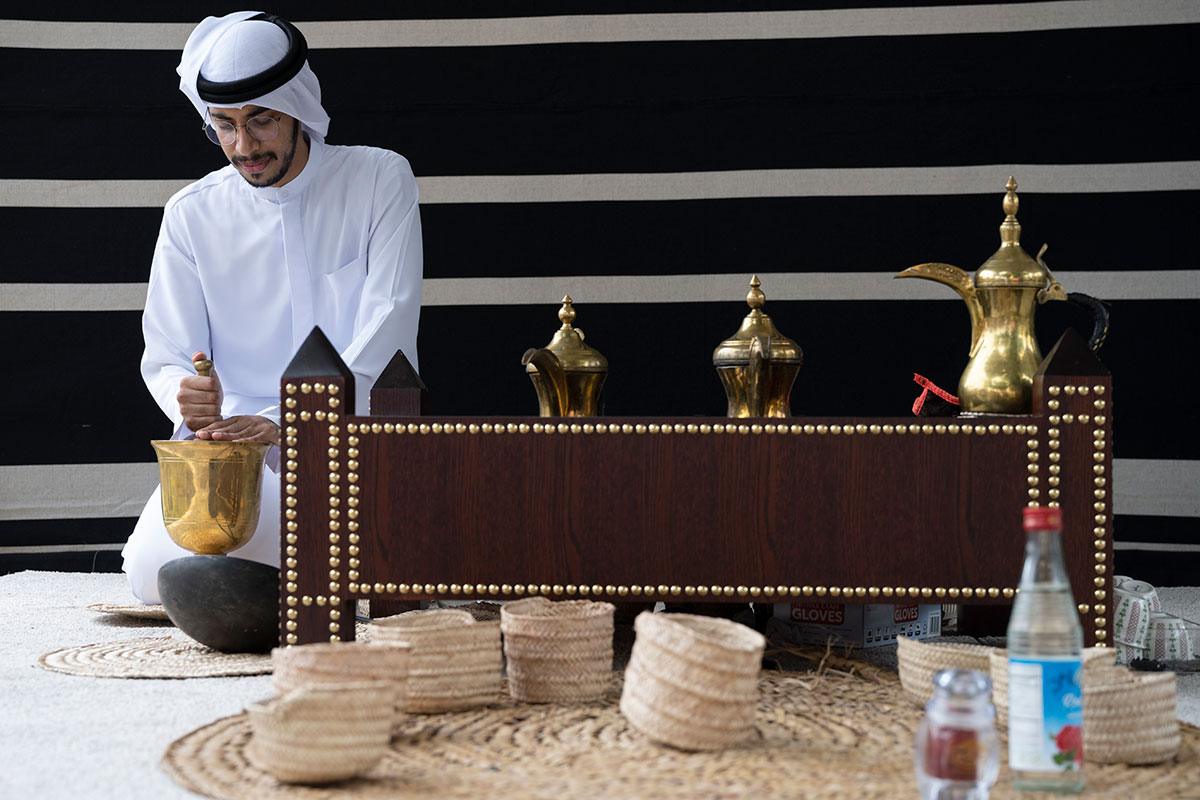The Welcoming Drink: Coffee Culture in the UAE

Ahmed Al Shimmari prepares traditional Arabic coffee at the 2022 Smithsonian Folklife Festival.
Photo by Yijo Shen, Ralph Rinzler Folklife Archives
In the United Arab Emirates, the clinking of pestle against mortar signals fresh gahwa, or traditional Arabic coffee, and anyone in the neighborhood is welcome to join.
“Being hospitable doesn’t mean that you have to do something big,” Ahmed Al Shimmari says. “A small thing like a cup of gahwa can bring together so many people.”
I met Al Shimmari at the Smithsonian Folklife Festival, where he and a team of experts from the UAE demonstrated the preparation of Arabic coffee and offered hourly tastings to visitors. As he struck the pestle against the brass wall of the mortar, he invited flocks of people to the Coffee tent. He began each demonstration this way, carefully calculating how much gahwa he needed to serve each inquisitive audience member.
As observers craned their necks to peer into the ornately engraved manhaz and rashad—traditional Arabic mortar and pestle—another participant explained how gahwa is deeply tied to Emirati hospitality and food culture. Ahmed Al Shimmari, Mariam Al Dhaheri, and Bashair Al Balooshi walked us through what gahwa means to them and how it brings together communities, even across oceans at the Festival.
I watched how Al Shimmari made gahwa and was lucky enough to sip the coffee while I conversed with him and his team. Gahwa is prepared differently throughout the Middle East, he explained, but it shares the same cultural meaning as “the welcoming drink.”
The first step is roasting the beans using the tawa, a rounded pot typically made of iron, and mehmas, a flat paddle used to mix the beans. To my surprise, the coffee beans appear green before getting toasted, allowing them to darken.
Al Shimmari then takes out three dallahs, traditional coffee pots that each serve a different purpose according to its size. The largest pot, called khamara, boils water while the beans roast. After the beans reach a light roast, which allows for the citrus notes to come out, he cools them down by tossing the beans up and down in the mebrada, a wicker net. As visitors’ eyes follow the undulating motion, Al Shimmari’s eyes scan the beans for the misshapen ones. He picks out the oddly shaped beans, ensuring homogeneity, to extract the best flavor profile.




Al Shimmari then places the beans into the mortar and, with the pestle, grinds them into a powder. The boiled water and coffee grounds then steep in the second largest dallah, the khamra. Al Shimmari sprinkles in ground cardamom and saffron, allowing them to infuse the gahwa with their rich flavors. While spicing gahwa depends on the region, it can also be enjoyed plain.
After a couple of minutes, Al Shimmari places a filter, made out of palm tree fibers, over the spout of the dallah. He pours the mixture into the final and smallest dallah, the mezalah, which is used to serve. It is proper etiquette for the muqahwi, the person serving, to try the gahwa before handing it to their guests. Al Shimmari pours a small amount into a fenjan, a small drinking cup.
Satisfied, Al Shimmari would start serving the audience, passing out paper cups to eager hands. My cup was aromatic and bitter with the distinct flavor of saffron. The sharpness can be softened with the sweetness of dried dates, or tamer.
Al Shimmari learned gahwa traditions from his parents, as most people do, although there are also gahwa training centers, a testament to its cultural significance in the Middle East. Al Dhaheri is the program unit head at Bait Al Gahwa, a training center in Abu Dhabi. It is essential to know why gahwa is important in Arab culture, she explained, emphasizing that it must be prepared in the same way from generation to generation. Without a firm understanding of all aspects of the tradition, it can slowly fade.
This philosophy of keeping and sharing a timeless tradition is translated across the Atlantic Ocean to Washington, D.C. As the audience flocked around the tent, eager to ask questions and to take a closer look at the delicately engraved brass, Al Shimmari reiterated the difference between Arab reverence for coffee and the American grab-and-go coffee culture. For many people across the Arabian Peninsula, coffee symbolizes community, friendship, and hospitality. Al Shimmari told me that coffee is considered even more important than food when it comes to Arabic hospitality etiquette. In the United States, coffee is something consumed on the go during the morning rush, as a quick pick-me-up in the afternoon, or as a late-night caffeine fix for night owls. Coffee is important in both cultures, but the ways that we construct life around this drink are vastly different.
All three participants reiterated that they found joy in sharing their culture and knowing that people are genuinely curious to learn more about Emirati heritage. They opened their arms to anyone who came under the tent and, just as in the UAE, were willing to share a fenjan of gahwa with them, hoping to spark conversation and create cultural understanding.

Mioko Ueshima is a Katzenberger intern at the Smithsonian Center for Folklife and Cultural Heritage and a rising junior at Georgetown University majoring in American studies with a minor in Japanese.

